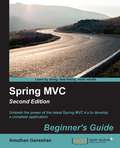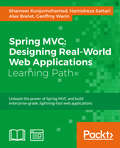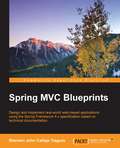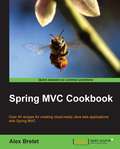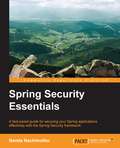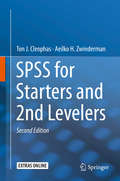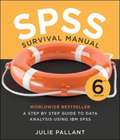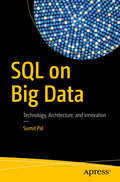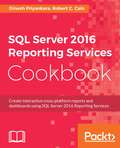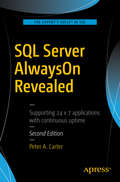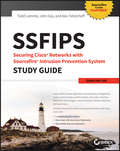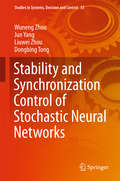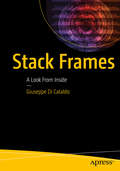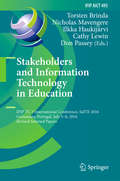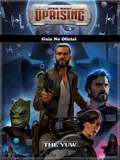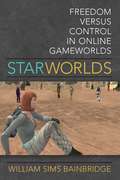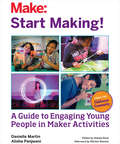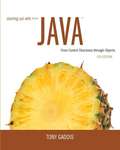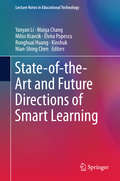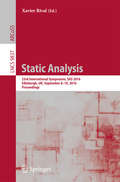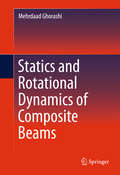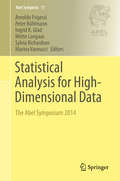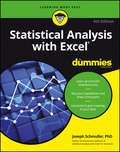- Table View
- List View
Spring MVC: Beginner's Guide - Second Edition
by Amuthan GaneshanUnleash the power of the latest Spring MVC 4.x to develop a complete application About This Book * Work through carefully crafted exercises with detailed explanations for each step will help you understand the concepts with ease * You will gain a clear understanding of the end-to-end request/response life cycle, and each logical component's responsibility * This book is packed with tips and tricks that demonstrate industry best practices on developing a Spring-MVC-based application Who This Book Is For The book is for Java developers who want to exploit Spring MVC and its features to build web applications. Some familiarity with basic servlet programming concepts would be a plus, but is not a prerequisite. What You Will Learn * Familiarize yourself with the anatomy of the Spring 4.X development environment * Understand web application architecture and the Spring MVC request flow * Integrate bean validation and custom validation * Use error handling and exception resolving * Get to grips with REST-based web service development and Ajax * Test your web application In Detail Spring MVC helps you build flexible and loosely coupled web applications. The Spring MVC Framework is architected and designed in such a way that every piece of logic and functionality is highly configurable. Also, Spring can integrate effortlessly with other popular web frameworks such as Struts, WebWork, Java Server Faces, and Tapestry. The book progressively teaches you to configure the Spring development environment, architecture, controllers, libraries, and more before moving on to developing a full web application. It begins with an introduction to the Spring development environment and architecture so you're familiar with the know-hows. From here, we move on to controllers, views, validations, Spring Tag libraries, and more. Finally, we integrate it all together to develop a web application. You'll also get to grips with testing applications for reliability. Style and approach This book takes a pragmatic step-by-step approach to web application development using Spring MVC, with informative screenshots and concise explanation.
Spring MVC: Designing Real-World Web Applications
by Hamidreza Sattari Alex Bretet Geoffroy Warin Shameer KunjumohamedUnleash the power of Spring MVC and build enterprise-grade, lightning-fast web applications About This Book * Configure Spring MVC to build logic-less controllers that transparently support the most advanced web techniques * Secure your developments with easy-to-write, reliable unit and end-to-end tests * Get this fast-paced, practical guide to produce REST resources and templates as required by the latest front-end best practices Who This Book Is For This Learning Path is for Java developers who want to exploit Spring MVC and its features to build web applications. It will help you step up in your career and stay up to date or learn more about Spring's web scalability. What You Will Learn * Set up and build standalone and web-based projects using Spring Framework with Maven or Gradle * Develop RESTful API applications for XML and JSON data transfers * Investigate Spring data access mechanisms with Spring Data Repositories * Generate templates for a responsive and powerful front end with AngularJS and Bootstrap * Authenticate over REST with a BASIC authentication scheme and OAuth2; handle roles and permissions * Communicate through WebSocket and STOMP messages * Design complex advanced-level forms and validate the model * Create maintainable unit and acceptance tests to secure the apps * Deploy the web application to the cloud in a snap In Detail Spring MVC helps you build flexible and loosely coupled web applications. The Spring MVC Framework is designed in such a way that every piece of logic and functionality is highly configurable. This Learning Path aims to make you an expert in designing web applications with Spring MVC 4. In our first module, we'll begin with an introduction to the Spring framework. You'll then learn aspect-oriented programming. Packed with real-world examples, you'll get an insight into how you can use Spring Expression Language in your applications to make them easier to manage and maintain. In the second module, you'll learn everything you need to build modern Spring-based enterprise web applications. From practical development techniques and useful tools from the wider Spring ecosystem, to the new JEE standards, the impact of JavaScript, and even the Internet of Things, you'll feel confident that you can deploy Spring for an impressive range of creative purposes. In the final module, you'll find out how to take advantage of Spring MVC's advanced features - essential if you are to properly master the framework. To do this you'll investigate the inner mechanics of Spring MVC, and how they tie into to the broader principles that inform many modern web architectures. With further guidance on how to test, secure, and optimize your application, as well as designing RESTful services, you'll very quickly be ready to use Spring in your next web project. This Learning Path combines some of the best that Packt has to offer in one complete, curated package. It includes content from the following Packt products: * Spring Essentials by Shameer Kunjumohamed, Hamidreza Sattari * Spring MVC Cookbook by Alex Bretet * Mastering Spring MVC 4 by Geoffroy Warin Style and approach This is a hands-on, practical guide based on logical modules of the whole Spring framework family, employing a combination of theory and examples with pro-level practices, techniques, and solutions.
Spring MVC Blueprints
by Sherwin John TraguraDesign and implement real-world web-based applications using the Spring Framework 4.x specification based on technical documentation About This Book * Learn all the details of implementing Spring 4.x MVC applications from basic core platform construction to advanced integration implementations * Gain a complete reference guide to implementing the controllers, models, views, view resolvers, and other service-related components to solve various real-world problems * Discover the possible optimal solutions for developers and experts to build enterprise and personal web-based applications * Create a Spring MVC application that has a validation process and exception handling with the HTTP status codes Who This Book Is For This book is for competent Spring developers who wish to understand how to develop complex yet flexible applications with Spring MVC. You must have a good knowledge of JAVA programming and be familiar with the basics of Spring. What You Will Learn * Set up and configure the Spring 4.x MVC platform from ground level up using the basic Spring Framework 4.x APIs * Study requirements and manage solutions on file uploading transactions in Spring 4.x applications Configure, , and test Spring integration to the Hibernate, MyBatis, and JPA frameworks for database transactions * Properly implement exception handlers and audit trails in Spring MVC applications * Generate reports using JFreeChart, Google Charts, JasperReports, DynamicReports, FreeMarker, Velocity, and Spring's API known as ContentNegotiatingViewResolver * Configure security and flexibility by adding Captcha, Spring Security, Spring Flow, Spring Portlets, JTA to improve data management performance * Implement web services using Spring's RESTful implementation and other service-oriented integration plugins * Design and implement a Spring 4.x application using AngularJS, ExtJs, Twitter Bootstrap, and Spring Mobile for responsive web design In Detail Spring MVC is the ideal tool to build modern web applications on the server side. With the arrival of Spring Boot, developers can really focus on the code and deliver great value, leveraging the rich Spring ecosystem with minimal configuration. Spring makes it simple to create RESTful applications, interact with social services, communicate with modern databases, secure your system, and make your code modular and easy to test. It is also easy to deploy the result on different cloud providers. This book starts all the necessary topics in starting a Spring MVC-based application. Moving ahead it explains how to design model objects to handle file objects. save files into a data store and how Spring MVC behaves when an application deals with uploading and downloading files. Further it highlights form transactions and the user of Validation Framework as the tool in validating data input. It shows how to create a customer feedback system which does not require a username or password to log in. It will show you the soft side of Spring MVC where layout and presentation are given importance. Later it will discuss how to use Spring Web Flow on top of Spring MVC to create better web applications. Moving ahead, it will teach you how create an Invoice Module that receives and transport data using Web Services By the end of the book you will be able to create efficient and flexible real-time web applications using all the frameworks in Spring MVC. Style and approach This book is a compendium of technical specification documents that will guide you through building an application using Spring 4.x MVC. Each chapter starts with a high-level wireframe design of the software followed by how to set up and configure different libraries and tools.
Spring MVC Cookbook
by Alex BretetOver 40 recipes for creating cloud-ready Java web applications with Spring MVC About This Book * Configure Spring MVC to build logic-less controllers that transparently support the most advanced web techniques * Build an amazing social and financial application that applies microservices patterns on deployment, self-testability, interoperability, cloud architectures, and scalability * Fast-paced, practical guide to learn how to set up Spring MVC to produce REST resources and templates as required by the latest front-end best practices Who This Book Is For If you are an experienced Java developer, with prior experience in web technologies, and want to step up in your career and stay up-to-date or learn more about Spring Web scalability, this book is for you. What You Will Learn * Structure your project with Maven and create self-tested, domain-specific deployable web archives * Generate templates for a responsive and powerful frontend with AngularJS and Bootstrap * Build a high performance stateless RESTful and hypermedia application to support your multiple customer experiences * Authenticate over REST with a BASIC authentication scheme and OAuth2; handle roles and permissions * Document and publish your REST API using Swagger and Swagger UI * Scale your Spring web application * Communicate through WebSocket and STOMP messages * Provide support to your application and efficiently maintain its business features with a relevant test stack In Detail Spring MVC is a lightweight application framework that comes with a great configuration by default. Being part of the Spring Framework, it naturally extended and supported it with an amazing set of recognizable annotations. External libraries can be plugged in and plugged out. It also possesses a request flow. Complete support of REST web services makes the Spring architecture an extremely consistent choice to support your front-end needs and Internet transformations. From the design of your Maven modules, you will achieve an Enterprise-standard for a stateless REST application based on Spring and Spring MVC with this book. This guide is unique in its style as it features a massive overview of practical development techniques brought together from the Spring ecosystem, the new JEE standards, the JavaScript revolution and Internet of Things. You will begin with the very first steps of Spring MVC's product design. Focused on deployment, viability, and maintainability, you will learn the use of Eclipse, Maven, and Git. You will walk through the separation of concerns driven by the microservices principles. Using Bootstrap and AngularJS, you will develop a responsive front-end, capable of interacting autonomously with a REST API. Later in the book, you will setup the Java Persistence API (JPA) within Spring; learn how to configure your Entities to reflect your domain needs, and discover Spring Data repositories. You will analyze how Spring MVC responds to complex HTTP requests. You will implement Hypermedia and HATEOAS to guide your customer's stateless conversation with the product and see how a messaging-service based on WebSocket can be configured. Finally you will learn how to set up and organize different levels of automated-tests, including logging and monitoring. Style and approach A comprehensive, recipe-based guide to creating stunning Java apps with Spring MVC as a result of learning and implementing pro-level practices, techniques, and solutions.
Spring Security Essentials
by Nanda NachimuthuA fast-paced guide for securing your Spring applications effectively with the Spring Security frameworkAbout This BookExplore various security concepts using real-time examples of the Spring Security frameworkLearn about the functionalities that implement industry standard authentication and authorization mechanisms to secure enterprise-level applicationsDesign and develop advanced Spring Security layers by following a step-by-step approachWho This Book Is ForIf you are a developer who is familiar with Spring and you are looking to explore its security features, then this book is for you. All beginners and experienced users will benefit from this book since it is explores both the theory and practical usage in detail.What You Will LearnSee industry standard security implementations in actionUnderstand the principles of security servers, concepts, installation, and integrationUse Spring Extensions for various security mechanismsGet to grips with the internals of the tools and servers involved in the security layerWork through practical projects and working programsCompare different security servers and techniquesUse the sample projects in practical, real-time applicationsGet further readings and guidance on advanced security mechanismsIn DetailSpring Security is a framework that focuses on providing both authentication and authorization to Java applications. Like all Spring projects, the real power of Spring Security is how easily it can be extended to meet custom requirements. The popularity of the Spring framework is increasing and the security package of Spring addresses vast mechanisms of Security in a rich way. Due to an increasing number of applications for various business needs, the integration of multiple applications is becoming inevitable. The standard security procedures available across multiple implementations in Spring will protect vulnerable applications that are open to larger public and private audiences.Spring Security Essentials focuses on the need to master the security layer, which is an area not often explored by a Spring developer.At the beginning, we'll introduce various industry standard security mechanisms and the practical ways to integrate with them. We will also teach you about some up-to-date use cases such as building a security layer for RESTful web services and applications.The IDEs used and security servers involved are briefly explained, including the steps to install them. Many sample projects are also provided to help you practice your newly developed skills. Step-by-step instructions will help you master the security layer integration with the Server, then implement the experience gained from this book in your own real-time application.Style and approachThis practical guide is packed with detailed explanations of the underlying concepts, as well as screenshots and working examples that guarantee hands-on learning.
SPSS for Starters and 2nd Levelers
by Ton J. Cleophas Aeilko H. ZwindermanFor medical and health workers this book is a must-have, because statistical methods in these fields are vital, and no equivalent work is available. For medical and health students this is equally true. A unique point is its low threshold, textually simple and at the same time full of self-assessment opportunities. Other unique points are the succinctness of the chapters with 3 to 6 pages, the presence of entire-commands-texts of the statistical methodologies reviewed and the fact that dull scientific texts imposing an unnecessary burden on busy and jaded professionals have been left out. For readers requesting more background, theoretical and mathematical information a note section with references is in each chapter. The first edition in 2010 was the first publication of a complete overview of SPSS methodologies for medical and health statistics. Well over 100,000 copies of various chapters were sold within the first year of publication. Reasons for a rewrite were four. First, many important comments from readers urged for a rewrite. Second, SPSS has produced many updates and upgrades, with relevant novel and improved methodologies. Third, the authors felt that the chapter texts needed some improvements for better readability: chapters have now been classified according the outcome data helpful for choosing your analysis rapidly, a schematic overview of data, and explanatory graphs have been added. Fourth, current data are increasingly complex and many i mportant methods for analysis were missing in the first edition. For that latter purpose some more advanced methods seemed unavoidable, like hierarchical loglinear methods, gamma and Tweedie regressions and random intercept analyses. In order for the contents of the book to remain covered by the title, the authors renamed the book: SPSS for Starters and 2nd Levelers. Special care was, nonetheless, taken to keep things as simple as possible. Medical and health professionals tend to dislike software syntax. Therefore, virtually no syntax, but, rather, simple menu commands are given. The arithmetic is still of a no-more-than high-school level. Step-by-step analyses of different statistical methodologies are given with the help of 60 SPSS data files available through the internet. Because of the lack of time of this busy group of people, the authors have given every effort to produce a text as succinct as possible.
SPSS Survival Manual: A Step By Step Guide to Data Analysis Using IBM SPSS
by Julie PallantThe SPSS Survival Manual throws a lifeline to students and researchers grappling with this powerful data analysis software. In her bestselling guide, Julie Pallant guides you through the entire research process, helping you choose the right data analysis technique for your project. From the formulation of research questions, to the design of the study and analysis of data, to reporting the results, Julie discusses basic and advanced statistical techniques. She outlines each technique clearly, with step- by-step procedures for performing the analysis, a detailed guide to interpreting data output and an example of how to present the results in a report. For both beginners and experienced users in psychology, sociology, health sciences, medicine, education, business and related disciplines, the SPSS Survival Manual is an essential text. Illustrated with screen grabs, examples of output and tips, it is supported by a website with sample data and guidelines on report writing. This sixth edition is fully revised and updated to accommodate changes to IBM SPSS procedures, screens and output. It covers new SPSS tools for generating graphs and non-parametric statistics, importing data, and calculating dates.
SQL on Big Data
by Sumit PalLearn various commercial and open source products that perform SQL on Big Data platforms. You will understand the architectures of the various SQL engines being used and how the tools work internally in terms of execution, data movement, latency, scalability, performance, and system requirements. This book consolidates in one place solutions to the challenges associated with the requirements of speed, scalability, and the variety of operations needed for data integration and SQL operations. After discussing the history of the how and why of SQL on Big Data, the book provides in-depth insight into the products, architectures, and innovations happening in this rapidly evolving space. SQL on Big Data discusses in detail the innovations happening, the capabilities on the horizon, and how they solve the issues of performance and scalability and the ability to handle different data types. The book covers how SQL on Big Data engines are permeating the OLTP, OLAP, and Operational analytics space and the rapidly evolving HTAP systems. You will learn the details of: Batch Architectures--Understand the internals and how the existing Hive engine is built and how it is evolving continually to support new features and provide lower latency on queries Interactive Architectures--Understanding how SQL engines are architected to support low latency on large data sets Streaming Architectures--Understanding how SQL engines are architected to support queries on data in motion using in-memory and lock-free data structures Operational Architectures--Understanding how SQL engines are architected for transactional and operational systems to support transactions on Big Data platforms Innovative Architectures--Explore the rapidly evolving newer SQL engines on Big Data with innovative ideas and concepts Who This Book Is For: Business analysts, BI engineers, developers, data scientists and architects, and quality assurance professionals
SQL Server 2016 Reporting Services Cookbook
by Robert C. Cain Dinesh PriyankaraCreate interactive cross-platform reports and dashboards using SQL Server 2016 Reporting Services About This Book * Get up to speed with the newly-introduced enhancements and the more advanced query and reporting features * Easily access your important data by creating visually appealing dashboards in the Power BI practical recipe * Create cross-browser and cross-platform reports using SQL Server 2016 Reporting Services Who This Book Is For This book is for software professionals who develop and implement reporting solutions using Microsoft SQL Server. It is especially relevant for professionals who are software engineers, software architects, DW/BI engineers, and DW/BI architects who perform simple to complex report authoring implementations. This book is also suitable for those who develop software solutions that integrate reporting solutions and are keen to learn about Microsoft SQL Server 2016's features and capabilities. What You Will Learn * Key capabilities, architecture, and components of Reporting Services * New features that have been added to Reporting Services * Design the architecture for reporting solutions * Design the architecture for BI solutions * Implement reporting solutions using Reporting Services * Improve the performance, availability, and scalability of the reporting solution * Enhance reporting solutions with custom programming and improved security In Detail Microsoft SQL Server 2016 Reporting Services comes with many new features. It offers different types of reporting such as Production, Ad-hoc, Dashboard, Mash-up, and Analytical. SQL Server 2016 also has a surfeit of new features including Mobile Reporting, and Power BI integration. This book contains recipes that explore the new and advanced features added to SQL Server 2016. The first few chapters cover recipes on configuring components and how to explore these new features. You'll learn to build your own reporting solution with data tools and report builder, along with learning techniques to create visually appealing reports. This book also has recipes for enhanced mobile reporting solutions, accessing these solutions effectively, and delivering interactive business intelligence solutions. Towards the end of the book, you'll get to grips with running reporting services in SharePoint integrated mode and be able to administer, monitor, and secure your reporting solution. This book covers about the new offerings of Microsoft SQL Server 2016 Reporting Services in comprehensive detail and uses examples of real-world problem-solving business scenarios. Style and approach This comprehensive cookbook follows a problem-solution approach to help you overcome any obstacle when creating interactive, visually-appealing reports using SQL Server 2016 Reporting Services. Each recipe focuses on a specific task and is written in a clear, solution-focused style.
SQL Server AlwaysOn Revealed
by Peter A. CarterGet a fast start to using AlwaysOn, the SQL Server solution to high-availability and disaster recovery. This second edition is newly-updated to cover the 2016 editions of both SQL Server and Windows Server. Also in this edition is all-new content on troubleshooting and metadata. The book provides a solid and accurate understanding of how to implement systems requiring consistent and continuous uptime, as well as how to troubleshoot those systems in order to keep them running an reliable. Begin with an introduction to high-availability and disaster recovery concepts such as Recovery Point Objectives (RPOs), Recovery Time Objectives (RTO), availability levels, and the cost of downtime. Then move into detailed coverage of implementing and configuring the AlwaysOn feature set in order to meet the business objectives set by your organization. SQL Server AlwaysOn Revealed offers real-world advice on how to build and configure the most appropriate topology to meet the high-availability and disaster recovery requirements you are faced with. Content includes strong coverage on implementing clusters, on building AlwaysOn failover clustered instances, and on configuring AlwaysOn Availability Groups. This is a practical and hand-on book to get you started quickly in using one of the most talked-about SQL Server feature sets. Teaches you to build HA and DR solutions using the AlwaysOn feature set Provides real-world advice on configuration and performance considerations Demonstrates administrative techniques for the AlwaysOn feature set What You Will Learn Understand high availability and disaster recovery in SQL Server 2016 Build and configure a Windows Cluster Create and configure an AlwaysOn failover clustered instance Implement AlwaysOn Availability Groups and appropriately configure them Administer AlwaysOn technologies post implementation Troubleshoot and resolve problems with misbehaving systems Who This Book Is For Database administrators interested in growing their knowledge and skills in Microsoft SQL Server's high-availability and disaster recovery feature set.
SSFIPS Securing Cisco Networks with Sourcefire Intrusion Prevention System Study Guide
by Alex Tatistcheff Todd Lammle John GayUp the ante on your Sourcefire IPS exam prep Securing Cisco Networks with Sourcefire IPS Study Guide, Exam 500-285 provides 100% coverage of the Securing Cisco Networks with Sourcefire IPS exam objectives. With clear and concise information regarding crucial security topics, this comprehensive guide includes practical examples and insights drawn from real-world experience, exam highlights, and end of chapter reviews. Learn key exam topics and powerful features of the Cisco Sourcefire System, including FireSIGHT technology, in-depth event analysis, IPS tuning and configuration, and snort rules language. Gain access to Sybex's superior online learning environment that includes practice questions, flashcards, and interactive glossary of terms. Use and configure next-generation Sourcefire technology, including application control, firewall, and routing and switching capabilities Understand how to accurately tune your systems to improve performance and network intelligence while leveraging powerful tools for more efficient event analysis Complete hands-on labs to reinforce key concepts and prepare you for the practical applications portion of the examination Access Sybex's online interactive learning environment and test bank, which includes an assessment test, chapter tests, bonus practice exam questions, electronic flashcards, and a searchable glossary Securing Cisco Networks with Sourcefire IPS Study Guide, Exam 500-285 provides you with the information you need to prepare for the Sourcefire IPS examination.
Stability and Synchronization Control of Stochastic Neural Networks
by Wuneng Zhou Jun Yang Liuwei Zhou Dongbing TongThis book reports on the latest findings in the study of Stochastic Neural Networks (SNN). The book collects the novel model of the disturbance driven by Levy process, the research method of M-matrix, and the adaptive control method of the SNN in the context of stability and synchronization control. The book will be of interest to university researchers, graduate students in control science and engineering and neural networks who wish to learn the core principles, methods, algorithms and applications of SNN.
Stack Frames
by Giuseppe Di CataldoTeaches you exactly how program memory content and organization is vital for computer security, especially Unix-like operating systems. You will learn how it is manipulated to take control of a computer system, as well as the countermeasures that system designers set up to avoid this. Neither a guide for hackers nor an all-out theory book, this book is ideal for anyone studying computer security who wants to learn by doing. Using a practical approach, you will understand how stack frames relate to hardware and software theory and the various GNU/Linux distributions, before moving on to Base 2, 8 and 16 notations, executables and libraries. Lastly you will go in-depth to understand the intricacies of stack frames. A vital resource for all computer security students and enthusiasts, add Stack Frames: A Look Inside to your library today. What You Will Learn In-depth knowledge on activation records of functions, and how this information can be used. A better understanding on how conventions used by compilers work. Clarify some concepts on libraries and their relationship with executable programs. Get, or recall, technical skills using compilers, debuggers, and other tools. Who This Book Is For The book is suitable for college students with a good knowledge of the C language, who are interested in deepening their study of the content and organization of program memory, namely the activation records of functions, as regards possible implications in computer security. A basic knowledge of both the Assembly language and the UNIX operating system is certainly helpful, as well as some practice with compilers and debuggers; but they are not compulsory.
Stakeholders and Information Technology in Education
by Torsten Brinda Nicholas Mavengere Ilkka Haukijärvi Cathy Lewin Don PasseyThis book constitutes the thoroughly refereed post-conference proceedings of the First IFIP TC 3 International Conference on Stakeholders and Information Technology in Education, SaITE 2016, held in Guimar#65533;es, Portugal, in July 2016. The 15 full papers presented together with 2 short papers were carefully reviewed and selected from 48 submissions. They are organized in four topical sections: computer studies - developing practices and involving stakeholders; teacher education - key stakeholder practices; developments in educational management; and information and communication technologies for social and national development.
Star Wars A Rebelião Guerra nas Estrelas
by Joshua Abbott Márcia de Medeiros SouzaVença os seus inimigos! Dicas avançadas e guiade estratégia. Esta é o guia com mais informações e o mais detalhado que encontrará online. Disponível para o download imediato em seu telefone, eBook, ou paperback. Com o sucesso de centenas de outros guias online e estratégias, escrevi este guia profissional avançado para novatos e veteranos. Isto dá estratégias específicas e derruba-as em como progredir no jogo, bate-as seus oponentes, adquire-as mais moedas e moeda corrente, mais muito mais! Aqui está o que você receberá comprando esse guia detalhado, avançado e profissional - Dicas profissionais e estratégias. - Burlar e hackear o jogo. - Segredos, dicas, hacks, desbloqueios, e truques usados pelos jogadores Pro! - Controles básicos. - Visão geral das habilidades. - Visão geral das dificuldades. - Equipamentos e itens. - Upgrades. - Missões de grupo - Viajando pela galáxia - Como conseguir muito Crômium - Como salvar e vender itens - Estratégias de Facebook e de Wiki online. - E MUITO MAIS! Todas as versões deste guia têm prints de tela para lhe ajudar a entender melhor o jogo. Não há nenhum outro guia tão detalhado e com mais informações. Se você estiver procurando as guias de outros jogos populares, procure por ebooks de Josh Abbott ou HiddenStuff Entertainment. Você ficará satisfeito com a compra deste guia. Ele possui muito mais informações que os outros guias encontrados por aí. Compre agora e destrua seus inimigos! Torna-se um jogador Pro hoje mesmo!
Star Wars Uprising Guía No Oficial
by I. Fernandez Joshua AbbottGuía No Oficial Consejos avanzados y Estrategia. Tienes ante ti la guía más detallada y completa que encontrarás en la red. Disponible para descargar en tu teléfono móvil, lector de eBooks o en papel. Tras el éxito de mis otras cientos de guías y estrategias he escrito otra guía avanzada y profesional para jugadores nuevos y veteranos. ¡Encontrarás estrategias y consejos sobre cómo avanzar en el juego, vencer a tus adversarios conseguir más monedas y mucho más! Consejos y estrategias profesionales ¡Secretos, trucos y trampas que utilizan jugadores pro! Cómo conseguir gran cantidad de dinero-monedas. ¡Y MUCHO MÁS! Todas las versiones de esta guía vienen con capturas de pantalla para ayudarte a comprender mejor el juego. No hay otra tan avanzada y completa como esta. Este producto no está asociado, afiliado, promocionado, certificado o patrocinado por el propietario original del copyright.
Star Worlds: Freedom Versus Control in Online Gameworlds
by William Sims BainbridgeStar Worlds explores the future-oriented universe of online virtual worlds connected with popular science fiction--specifically, with Star Wars and Star Trek--that have been inhabited for over a decade by computer gamers. The Star Wars and Star Trek franchises, both of which have shaped the dominant science fiction mythologies of the last half-century, offer profound conceptions of the tension between freedom and control in human economic, political, and social interactions. Bainbridge investigates the human and technological dynamics of four online virtual worlds based on these two very different traditions: the massive multiplayer online games Star Wars Galaxies; Star Wars: The Old Republic; Star Trek Online; and the Star Trek community in the non-game, user-created virtual environment, Second Life. The four "star worlds" explored in this book illustrate the dilemmas concerning the role of technology as liberator or oppressor in our post-industrial society, and represent computer simulations of future possibilities of human experience. Bainbridge considers the relationship between a real person and the role that person plays, the relationship of an individual to society, and the relationship of human beings to computing technology. In addition to collecting ethnographic and quantitative data about the social behavior of other players, he has immersed himself in each of these worlds, role-playing 14 avatars with different skills and goals to gain new insights into the variety of player experience from a personal perspective.
Start Making!: A Guide to Engaging Young People in Maker Activities
by Alisha Panjwani Danielle Martin Natalie RuskStart Making! is a program developed by the Clubhouse Network to engage young people all over the world in Maker-inspired activities. With this guide, you will discover how to plan and coordinate Start Making! projects in your home, school, library, community center, after-school club, or makerspace. You'll learn strategies for engaging young people in creative thinking, developing individual and team projects, and sharing and reflecting on their creations.Each session includes a list of the supplies you'll need, step-by-step instructions for completing the projects, and prompts for stimulating discussion, curiosity, and confidence. These fun do-it-yourself (and do-it-together) projects teach fundamental STEAM concepts -- science, technology, engineering, art, and math -- while introducing young people to the basics of circuitry, design, coding, crafting, and construction. They'll make paper cards and creations that light up, play music using a MaKey MaKey keyboard and Scratch programming, join together to make paintings with light, design and construct 3D sculptures, build a vibrating art-bot that makes drawings, and sew fabric creations with wearable circuits.Dip into the activities once a week, run them as a week-long summer activity, or go through the guide in any way that works for you. By offering your own Start Making! program, you can inspire young people in your community to develop creative ideas, learn new skills, and share their creations.The Clubhouse Network is a global network of community-based centers led by Boston's Museum of Science in collaboration with the MIT Media Lab.
Starting Out with Java: From Control Structures through Objects
by Tony GaddisFor courses in computer programming in Java Starting Out with Java: From Control Structures through Objects provides a brief yet detailed introduction to programming in the Java language. Starting out with the fundamentals of data types and other basic elements, readers quickly progress to more advanced programming topics and skills. By moving from control structures to objects, readers gain a comprehensive understanding of the Java language and its applications. As with all Gaddis texts, the Sixth Edition is clear, easy to read, and friendly in tone. The text teaches by example throughout, giving readers a chance to apply their learnings by beginning to code with Java.
State Fragility Around the World: Fractured Justice and Fierce Reprisal
by Laurie A. Gould Matthew PateFailed and fragile states often govern through the criminalization of otherwise inconsequential or tolerated acts. These weak states also frequently use kidnapping, murder, and other violent or oppressive tactics to maintain order and stay in power. State Fragility Around the World: Fractured Justice and Fierce Reprisal analyzes the path to state f
State-of-the-Art and Future Directions of Smart Learning
by Nian-Shing Chen Kinshuk Ronghuai Huang Elvira Popescu Milos Kravcik Maiga Chang Yanyan LiThis book provides an archival forum for researchers, academics, practitioners and industry professionals interested and/or engaged in reforming teaching and learning methods by transforming today's learning environments into smart learning environments. It will facilitate opportunities for discussions and constructive dialogue between various stakeholders on the limitations of current learning environments, the need for reform, innovative uses of emerging pedagogical approaches and technologies, and sharing and promoting best practices, which will lead to the evolution, design and implementation of smart learning environments. The focus of the contributions is on the interplay and fusion of pedagogy and technology to create these new environments. The components of this interplay include but are not limited to: Pedagogy: learning paradigms, assessment paradigms, social factors, policy Technology: emerging technologies, innovative uses of mature technologies, adoption, usability, standards, and emerging/new technological paradigms (open educational resources, cloud computing, etc. ) Fusion of pedagogy and technology: transformation of curricula, transformation of teaching behavior, transformation of administration, best practices of infusion, piloting of new ideas.
Static Analysis
by Xavier RivalThis book constitutes the refereed proceedings of the 23rd International Static Analysis Symposium, SAS 2016, held in Edinburgh, UK, in September 2016. The 21 papers presented in this volume were carefully reviewed and selected from 55 submissions. The contributions cover a variety of multi-disciplinary topics in abstract domains; abstract interpretation; abstract testing; bug detection; data flow analysis; model checking; new applications; program transformation; program verification; security analysis; theoretical frameworks; and type checking.
Statics and Rotational Dynamics of Composite Beams
by Mehrdaad GhorashiThis book presents a comprehensive study of the nonlinear statics and dynamics of composite beams and consists of solutions with and without active elements embedded in the beams. The static solution provides the initial conditions for the dynamic analysis. The dynamic problems considered include the analyses of clamped (hingeless) and articulated (hinged) accelerating rotating beams. Two independent numerical solutions for the steady state and the transient responses are presented. The author illustrates that the transient solution of the nonlinear formulation of accelerating rotating beam converges to the steady state solution obtained by the shooting method. Other key areas considered include calculation of the effect of perturbing the steady state solution, coupled nonlinear flap-lag dynamics of a rotating articulated beam with hinge offset and aerodynamic damping, and static and dynamic responses of nonlinear composite beams with embedded anisotropic piezo-composite actuators. The book is intended as a thorough study of nonlinear elasticity of slender beams and is targeted to researchers, graduate students, and practicing engineers in the fields of structural dynamics, aerospace structures, and mechanical engineering.
Statistical Analysis for High-Dimensional Data
by Arnoldo Frigessi Peter Bühlmann Ingrid K. Glad Mette Langaas Sylvia Richardson Marina VannucciThis book features research contributions fromThe Abel Symposium on Statistical Analysis for High Dimensional Data, held inNyvågar, Lofoten, Norway, in May 2014. The focus of the symposium was on statisticaland machine learning methodologies specifically developed for inference in "bigdata" situations, with particular reference to genomic applications. Thecontributors, who are among the most prominent researchers on the theory ofstatistics for high dimensional inference, present new theories and methods, aswell as challenging applications and computational solutions. Specific themesinclude, among others, variable selection and screening, penalised regression,sparsity, thresholding, low dimensional structures, computational challenges,non-convex situations, learning graphical models, sparse covariance andprecision matrices, semi- and non-parametric formulations, multiple testing,classification, factor models, clustering, and preselection. Highlighting cutting-edge researchand casting light on future research directions, the contributions will benefitgraduate students and researchers in computational biology, statistics and themachine learning community.
Statistical Analysis with Excel For Dummies
by Joseph SchmullerReaders use statistics every day, even when they don't realize it. Statistical Analysis with Excel For Dummies, Fourth Edition shows readers how to use the world's most popular spreadsheet program to crunch the numbers and interpret statistics--even if they haven't taken a statistics or advanced math course. Statistics have a reputation for being a challenging, math intensive pursuit. Using plain English and a minimum of equations, this book offers readers a painless and easy understanding of statistics. Author Joseph Schmuller Ph.D. covers formulas and functions, charts and PivotTables, samples and normal distributions, probabilities and related distributions, trends and correlations, and much more. By the end of the book, readers understand statistical terms such as median vs. mean, margin of error, standard deviation, permutations and correlations. This book minimizes the use of intimidating equations and allows readers to understand statistics as quickly and painlessly as possible. With the upcoming release of the fourth edition, new and returning readers will have the ability to gain an increased knowledge of business analytics, statistical sophistication and the latest new features that come with Excel 2016.
